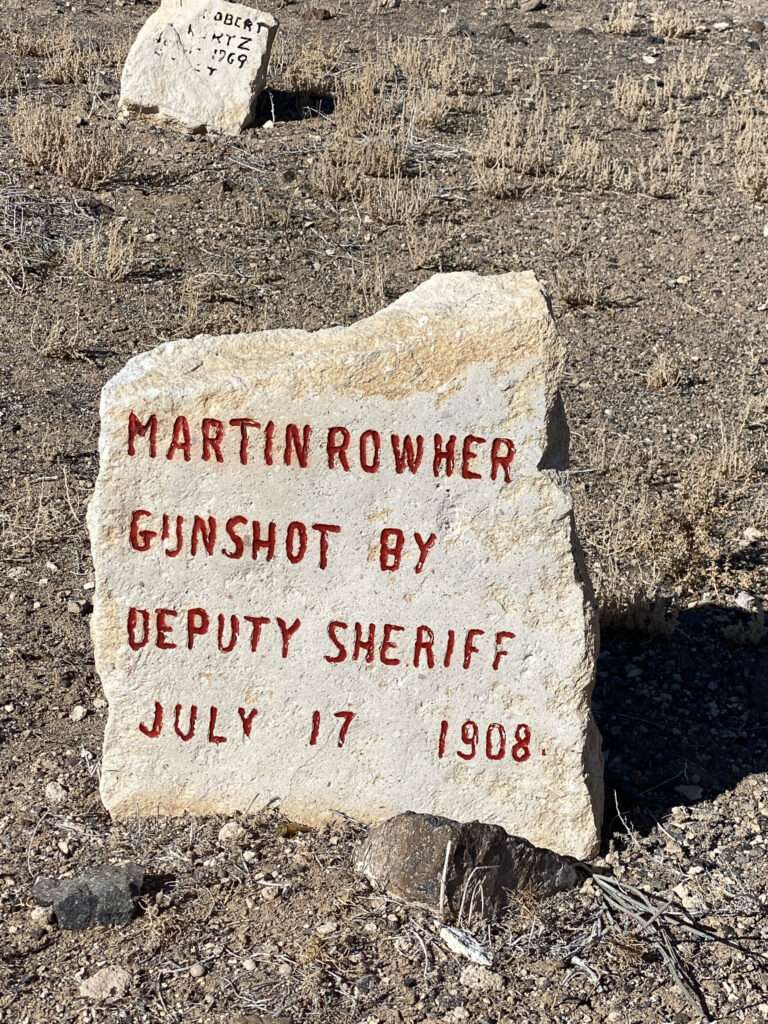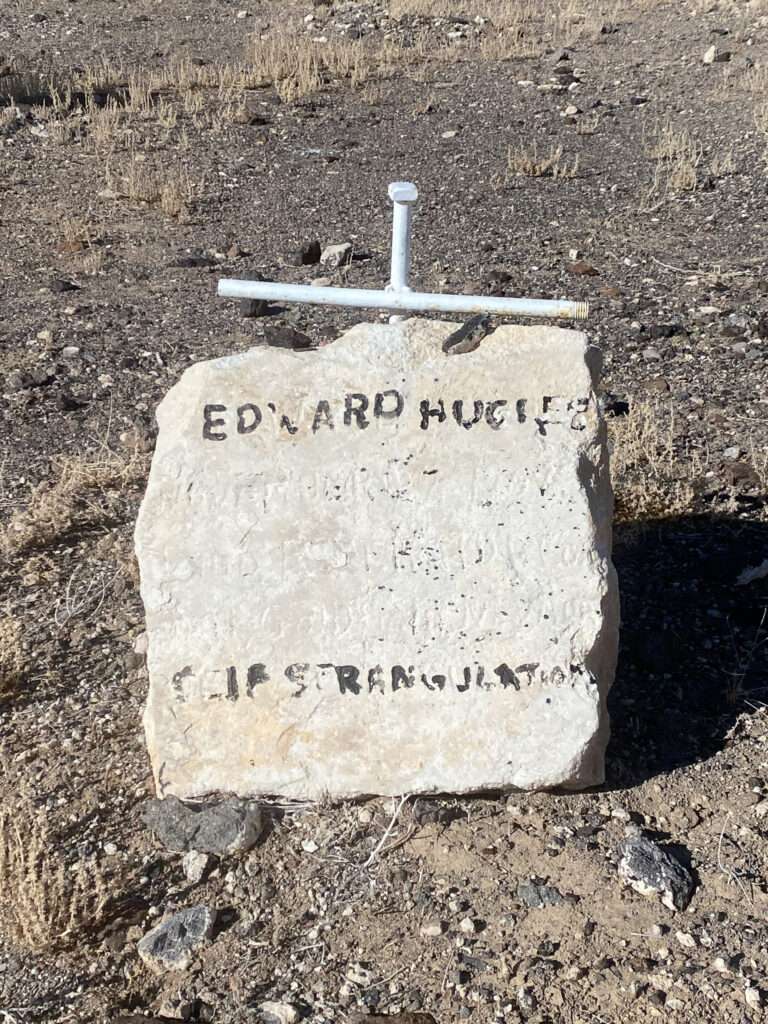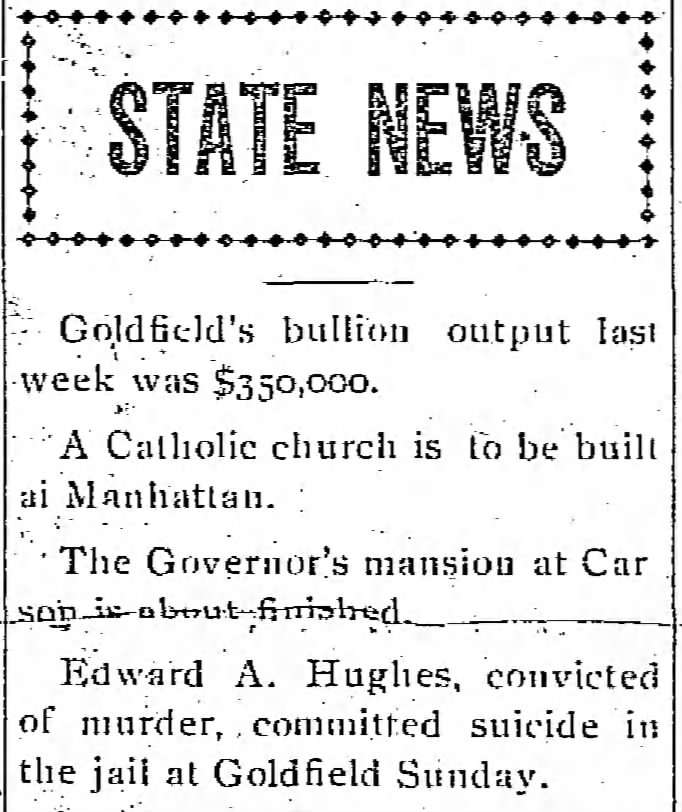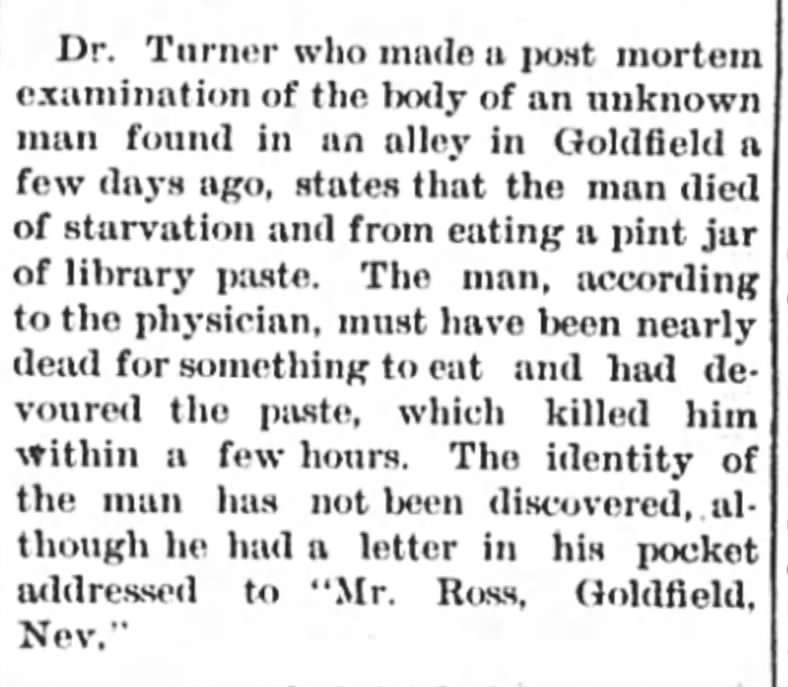
Nevada is full of unique and wild experiences with history, including visiting cemeteries for fun. Yes, going to graveyards for entertainment purposes. Unlike today’s simple grave markers, headstones from the mining camp days are often a story in themselves. Headstones range from tales of gunfights to heroic acts, tragic and poignant deaths, and the downright quirky. One of the most famous headstones is in Goldfield, “Unknown man died eating library paste.” Wait what? Doesn’t everyone over the age of five know not to eat library paste? Who was the man, why was he a paste eater and who were the Goldfield’s “Official Ghouls”?

“Greatest gold camp ever known…”

(Photo credit: Goldfield Historical Society)
Following the discovery of rich gold deposits, thirty-six prospectors and investors met to establish a new town. Goldfield sprang to life on October 20, 1903, starting as a tent city.

(Photo credit: Wikipedia)
Before a year had passed, Goldfield boomed, soon to become the largest city in Nevada. The town built beautiful stone buildings, including a school, courthouse and fire department. The San Fransisco Examiner dubbed Goldfield the “Greatest Gold Camp Ever Known.”

May 3, 1905



The Goldfield Hotel is the most iconic feature of the town. Completed in 1908, it was the most elegant hotel in Nevada. Appointments included crystal chandeliers, mahogany trim, leather-covered seating and gilded accents. The 150 rooms, most with a private bathroom, carpet, mirrors, and even a telephone. An on-site power plant provided steam heat.

Goldfield Union Cemetery
Goldfield continued to grow, and soon another resource was a needed – a cemetery. Some parts of the “Good old days” were not so good. In mining camps, death was a common occurrence. Now easily treated medical conditions were fatal, fires burned uncontrolled, mining accidents were frequent, and Goldfield had its share of shootings.

May 19, 1905
The first recorded burial in Goldfield was in 1905. Not realizing the explosion Goldfield would soon experience, the cemetery was conveniently located in the middle of town.

July 14, 1905
Under the supervision of the Miner’s Union, the Goldfield Union Cemetery was established. The cemetery was forty acres, half donated by Railroad Townsite. As was typical, the cemetery was divided into plots for each religion and fraternal organization.
God’s Acre is Free
Goldfield Weekly News and Tribune
September 15, 1905
A “citizen’s plot” was created, with burials provided at no cost. The cemetery was a “free, co-operative burial place for the citizens of Goldfield.”

September 15, 1905
Now arriving on platform 1
Soon railroads arrived in Goldfield, an astonishing five in total. The Las Vegas and Tonopah Railroad Company planned their tracks and station to disembark at the Goldfield Hotel.
Trains, like time and tide, stop for no one.
Jules Vernon

(Photo credit: Legends of America)
Goldfields “Official Ghouls”
One small problem with the depot’s location; the Goldfield Hotel was across from the Goldfield Union Cemetery. The railroad decided it would be bad business for travelers to arrive at their destination and step off the train into a graveyard. The Goldfield Hotel also decided they no longer wanted patrons to have a view overlooking a graveyard.

In 1908, the cemetery was moved north of Goldfield. Working under cover of darkness, “Official Ghouls” exhumed the graves, reinterring the remains at the new Pioneer Cemetery. The Official Ghouls were likely not pillars of the community and some question if they relocated all seventy graves.

One casket was interred in the Elk’s section of the cemetery, along with the headstone — the remaining graves were left unmarked.

Goldfield’s Pioneer Cemetery

Headstones were made from irregularly cut local stone. The care and detail that went into the markers show the prosperity of Goldfield; in many towns graves only had a simple wood cross or were unmarked. In Goldfield, each was carved with details about the grave’s occupant. One hundred and fifty-four souls were buried at the cemetery. The most famous burial was Virgil Earp, as in the Gunfight at the OK Corral. Later his family relocated his remains to Oregon.

The Pioneer Cemetery has numerous unusual headstones, at least by today’s standards. They are unique and often quirky, but each tells a story. They contain anecdotes of aliases, strangulation, gunshots… and jealous rage.





One headstone has faded but reads “Edward Hughes. November 27, 1909. Died at Esmerelda county jail, Goldfield, Nevada. Self-strangulation.”

Edward had been convicted of murdering a “man who sought his wife’s affections.”

March 22, 1909
Before being transferred to the state prison in Carson City to serve his sentence, Hughes committed suicide by hanging.

April 3, 1909
Eating library paste?

The most famous grave in Goldfield, possibly in Nevada, is “Unknown Man died eating library paste.” Upon seeing the unexpected headstone, some scratch their heads, some laugh at the macabre inscription and others believe it to be a hoax.

July 20, 1908
Travelers frequently visit and photograph the grave as part of wild and weird Nevada. Some say the headstone is a prank due to the condition of the stone and red lettering and the seeming silliness of the story. Laughing doubters take heed: the story is true. Multiple new reports around the state confirm the incident. In a day where deaths were common, the paste eater’s death was a tale spread far and wide.

Who was the paste eater?
Who was the man who made a meal of library paste? He stumbled into Goldfield, “nearly starved.” Digging through the Goldfield Library trash, he found a jar of library paste. He took his treasure to an alley behind an automobile garage and consumed the contents.

Library paste may seem like a strange item to eat, but it is made from flour. To the poor starving man, it probably smelled like delicious bread.
Unfortunately, library paste also contains alum, which is fatal in high quantities. County Physician, Dr. Turner, performed the autopsy on the unknown man. The man was emaciated and his internal organs were in a state of near starvation. Due to his poor health, the library paste killed him within hours.
Mr. Ross, Goldfield Nev.
There was only one clue about the unknown man, a letter in his pocket addressed to “Mr. Ross, Goldfield, Nev.” Mr. Ross was alive and well in Goldfield. Was the unknown man delivering a letter to Mr. Ross?

Sadly, we will never know the grave’s occupant’s identity. Likely, he was another prospector looking to stake his claim in the greatest gold camp ever known.
Ghost towing
On a trip to be interviewed at Radio Goldfield, I explored Goldfield and Tonopah, which are like open-air museums. In my free time, I researched who was Mizpah’s Lady in Red and the “Unknown Man died eating library paste.”

International Car Forest of the Last Church
***A special thank you to Allen Metscher, a walking history encyclopedia in Nye and Esmerelda Counties, and the Central Nevada Museum.
WANT MORE GHOST TOWNS?
For information on more than five hundred ghost towns in Nevada & California, visit the Nevada Ghost Towns Map or a list of Nevada ghost towns.

References
- Central Nevada Museum: Allen Metscher
- Daily Independent, July 24, 1908
- Find a Grave: Died eating library paste
- Find a Grave: Goldfield Pioneer Cemetery
- Goldfield Cemetery
- Goldfield Historical Society
- Goldfield Weekly News and Tribune: May 19, 1905
- Goldfield Weekly News and Tribune, July 14, 1905
- Goldfield Weekly News and Tribune, September 15, 1905
- Legenda of America: Las Vegas & Tonopah Railroad
- National Park Service: Goldfield, Nevada: Reconisince survey
- San Fransisco Examiner, May 3, 1905
- Reno-Gazette Journal, March 22, 1909
- Reno Gazette-Journal, July 20, 1908
- Travel Nevada: Goldfield Historic Cemetery
- Wikipedia: Goldfield, Nevada
- Yerington Times, April 3, 1909
Roger Peterson says
Great report and pictures once again! Thanks!
Tami says
Thank you!
Henry says
Along with Ghost Towns / Mines I also visit old cemeteries. On a visit a few months ago, I found the following sad grave at the Goldfield Cemetery that read – “John R. Goodwin age 2 yr 4 mn Aug. 9, 1908. ‘Drowned in a Water Barrel’ Water St. Goldfield, son of Nellie and Walter.” I was surprised to find several graves of Confederate soldiers, being so far from the South. It’s all history that I enjoy. You do a great job on your site. I’ll be in the area of Goldfield this weekend; do you have any plans to be in the area?
Tami says
I missed that headstone. How terrible for the family.
I’m not surprised by the Confederate Soldiers; there were strong ties to both sides of the Civil War in Nevada. Places like Unionville and Dixie Valley were named after towns’ sympathies.
I’m not sure when I will be in Goldfield. I have a trip in a few weeks, but we will turn off at Tonopah. Enjoy your weekend, I hope the weather cooperates.
Arnie says
Thank You Tami.
Tami says
Welcome!
Anonymous says
Great article Tami, It’s funny what makes a town famous but dying from eating library paste is one of the things that makes us famous – along with the ever present Ghost Stories.
Tami says
Good point, it is interesting what makes a town famous. Ghosts are popular in Goldfield and Tonopah!
Bill Moriarty says
Another GREAT STORY!
Tami says
Thank you Bill!
Christopher says
Sweet news on our hard working relatives